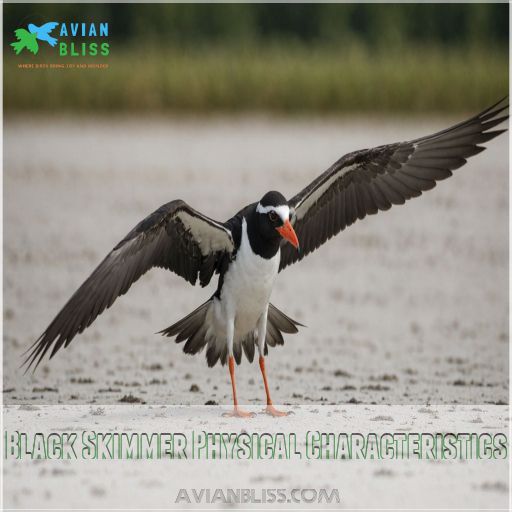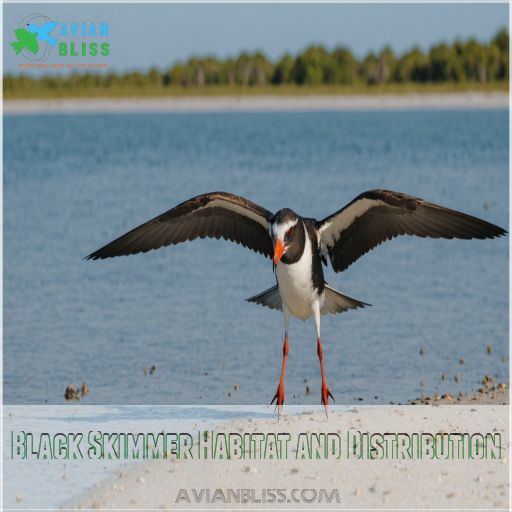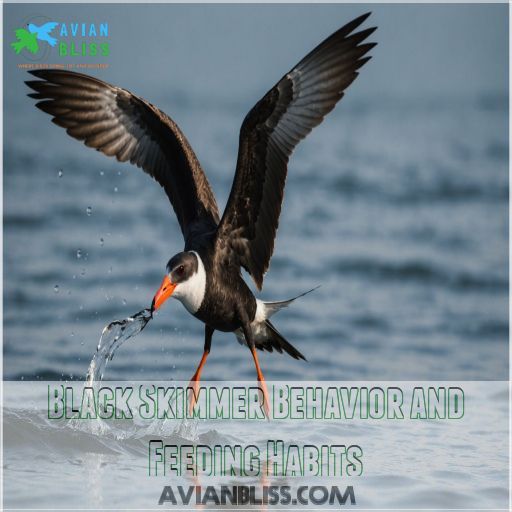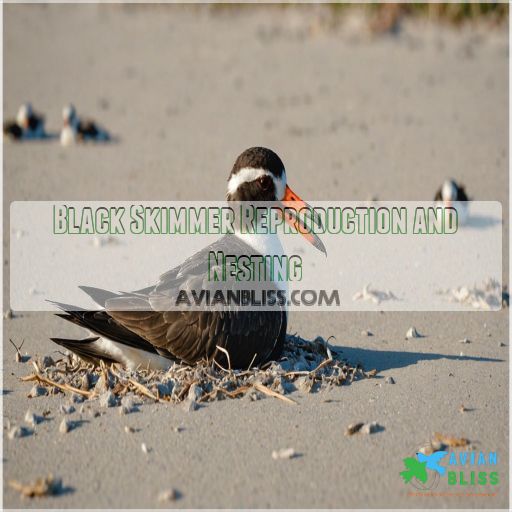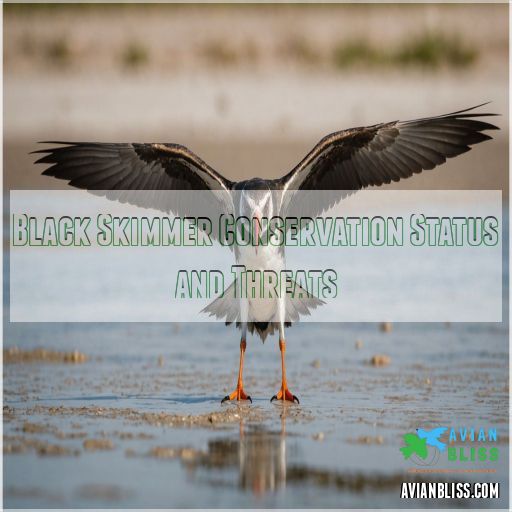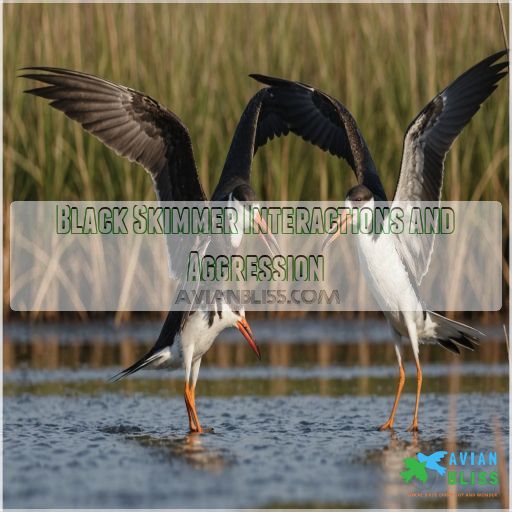This site is supported by our readers. We may earn a commission, at no cost to you, if you purchase through links.
 assistant
assistant
You’re scanning the horizon, and suddenly, you spot a distinctive bird with a uniquely shaped bill, the Black Skimmer.
This medium-sized ternlike seabird is a master of efficiency, using its lower mandible to skim the water’s surface in search of small fish and crustaceans.
With its vertical and enhanced vision, it can thrive in low light conditions. But what’s behind its remarkable ability?
Let’s take a closer look at its habitat and explore what makes the Black Skimmer an expert at finding food in coastal areas, where the remarkable ability to skim the water’s surface is a key to its survival, and how it uses its lower mandible to do so, and its master of efficiency to make the most of its environment.
Table Of Contents
- Key Takeaways
- Black Skimmer Physical Characteristics
- Black Skimmer Habitat and Distribution
- Black Skimmer Behavior and Feeding Habits
- Black Skimmer Reproduction and Nesting
- Black Skimmer Conservation Status and Threats
- Black Skimmer Migration Patterns
- Black Skimmer Interactions and Aggression
- Frequently Asked Questions (FAQs)
- What does a black skimmer do?
- What does a black skimmer look like?
- What does a skimmer bird do?
- What is a Niger skimmer?
- What do Black Skimmers do?
- Where do Black Skimmers migrate to?
- Is the Black Skimmer native to Florida?
- Are Black Skimmers aggressive?
- Do Black Skimmers return to same nesting sites yearly?
- How far do Black Skimmers travel during migration?
- How do Black Skimmers select mates for breeding?
- What is the average lifespan of a Black Skimmer?
- Do Black Skimmers use the same breeding colonies yearly?
- Conclusion
Key Takeaways
- You’re probably wondering how the Black Skimmer’s unique feeding style helps it thrive in coastal areas – it’s all about efficiency. By using its lower mandible to skim the water’s surface, this shorebird can catch fish and crustaceans in low-light conditions, giving it a leg up on the competition.
- As you explore the Black Skimmer’s habitat, you’ll notice it’s not just about the birds – it’s about the ecosystem as a whole. These shorebirds play a crucial role in maintaining the balance of their coastal ecosystems, and their loss could have serious ripple effects.
- If you’re concerned about the Black Skimmer’s conservation status, you’re not alone. Habitat loss, climate change, and human disturbance are all major threats to these birds, and it’s up to us to take action to protect them. By supporting conservation efforts and making eco-friendly choices, you can help ensure the Black Skimmer’s survival.
- Get ready to be amazed by the Black Skimmer’s remarkable migration patterns – these birds travel thousands of miles each year, braving treacherous weather conditions and predators along the way. By studying their migration routes, we can gain a deeper understanding of the challenges they face and work to protect their habitats.
Black Skimmer Physical Characteristics
As you take a closer look at the Black Skimmer, you’ll notice its distinctive physical characteristics, including a uniquely shaped bill and striking red and black coloration.
From the vertical pupils that aid its exceptional vision to its long, slender wings, the Black Skimmer’s design is perfectly adapted to its coastal environment and specialized feeding habits.
Bill and Face Structure
As you observe the Black Skimmer, notice its distinctive bill evolution and face structure, a result of adaptation benefits.
The lower mandible extends beyond the upper, creating an uneven bill shape that aids in prey capture, particularly when foraging in shallow waters.
This unique feeding mechanism is a key to bird identification.
Vertical Pupils and Enhanced Vision
Freedom to forage at night and navigate harsh sand glare – that’s what the Black Skimmer’s unique vertical pupils offer.
These adaptations enable enhanced vision, a key asset for detecting underwater prey in low light conditions.
Imagine being able to pinpoint fish in the dark, a skill that makes this ternlike seabird a master of its domain.
Red and Black Bill Coloration
When observing Black Skimmers, you’ll notice their distinctive red and black bill coloration, which serves an evolutionary purpose.
This unique coloring may act as a mating signal, while also providing camouflage in their coastal habitats.
Color variation can be seen in different regions, including South America.
Long Wings for Efficient Flight
You’re about to take flight with one of America’s most unique shorebirds – the Black Skimmer. Long wings are key to this bird’s efficient flight, with a wingspan reaching up to 20 inches.
- Aerodynamic advantage: Long wings help reduce drag and increase lift, allowing for smoother gliding over shallow bays and sandy beaches.
- Energy efficiency: By using rising air currents, Black Skimmers can conserve energy and stay aloft for longer periods.
- Gliding experts: With wings set, they can cover great distances without flapping, making them well-adapted to their coastal habitats.
- Adaptable flyers: Black Skimmers can adjust their flight speed to navigate through dense flocks and avoid human disturbances.
Measurements and Size Comparison
At sea level, amidst the cries of gulls, you’ll find the Black Skimmer, a medium-sized ternlike seabird with impressive wings and an oversized bill.
With a length of 15.8-19.7 in (40-50 cm) and wingspan of 42.9-45.3 in (109-115 cm), they’re larger than Laughing Gulls, yet smaller than Royal Terns, which makes them a notable medium-sized bird.
Black Skimmer Habitat and Distribution
When you’re trying to spot a Black Skimmer, you’ll want to head to the coastal waters, estuaries, and inlets along North America’s coasts – from California to Florida and the Mid-Atlantic region.
You might also find them in inland lakes, like those in Florida and the Salton Sea, where they nest on sandy islands, beaches, and shell banks.
Coastal Waters and Estuaries
Immerse yourself in the lives of Black Skimmers, where coastal waters and estuaries are their bread and butter.
These shorebirds thrive in protected areas like lagoons, inlets, and sheltered bays.
Estuary food webs, influenced by salt marshes, support their diet of small fish and crustaceans.
North American Coasts and Expanded Range
Along North America’s coasts, Black Skimmers have expanded their range, adapting to new habitats.
On the West Coast, they’ve colonized southern California since the 1960s, and can be found in locations such as the Salton Sea and San Diego.
However, coastal development threatens their habitats, leading to competition and interactions with other species like the Royal Tern.
Inland Lakes and Nesting Sites
As you explore the Black Skimmer’s habitat, you’ll find they occasionally venture inland to large lakes, particularly in Florida and California.
When selecting nesting sites, they prefer open sandy areas, gravel or shell bars with sparse vegetation.
This adaptability is essential for their survival, highlighting the need for conservation efforts to protect their habitat suitability and address human impact.
Impact of Coastal Habitat Development
Coastal development threatens the Black Skimmer’s habitat, leading to coastal erosion, nesting site loss, and pollution impact (Source). Human disturbance, such as beach maintenance, also affects their colonies.
To mitigate these effects, habitat restoration efforts are necessary.
- Support conservation organizations that focus on coastal habitat.
- Participate in beach cleanups to reduce pollution.
- Respect Black Skimmer colonies and avoid disturbing their nesting sites.
Black Skimmer Behavior and Feeding Habits
As you watch a black skimmer in action, you’ll notice its unique feeding behavior, where it uses its distinctive lower mandible to skim the water’s surface in search of food.
By understanding the black skimmer’s behavior and feeding habits, you’ll gain insight into what makes this shorebird so remarkable and how it’s adapted to its environment.
Skimming Feeding Habit and Use of Lower Mandible
When you watch a Black Skimmer in action, you’ll notice its unique feeding habit. The bird flies low over the water, using its elongated lower mandible to skim the surface for fish in an adaptation that allows foraging, especially in calm waters.
| Skimming Stage | Lower Mandible Movement | Upper Mandible Action |
|---|---|---|
| Initial Contact | Enters the water, scooping up fish | Remains open, waiting for contact |
| Fish Detection | Closes, trapping the fish | Snaps shut, securing the catch |
| Retrieval | Lifts out of the water, whipping the fish out | Remains closed, holding the prey |
Foraging in Evening or at Night
Now that you’re familiar with the Black Skimmer’s unique feeding habit, let’s take a closer look at their fascinating foraging behavior. Unlike most birds, they often forage in the evening or at night, taking advantage of calmer waters and fish swimming closer to the surface.
- Moonlit foraging: Black Skimmers use the moon’s light to navigate and locate prey.
- Tidal influence: They synchronize their foraging with tidal patterns to increase their chances of catching fish.
- Sensory adaptations: Their vertical pupils help reduce glare, while their sensitive lower mandible detects prey in the dark.
- Prey selection: By foraging at night, Black Skimmers can target specific fish species that are more active during this time.
Diet and Food Sources
As you observe Black Skimmers foraging, notice their unique feeding style, using their lower mandible to skim the water’s surface.
Their diet primarily consists of small fish, like killifish and silversides, as well as some crustaceans.
| Food Source | Description | Prey Preference |
|---|---|---|
| Killifish | Small fish, often found in shallow waters | High |
| Silversides | Small schooling fish, common in coastal areas | High |
| Crustaceans | Shrimp, blue crab, and other small crustaceans | Low |
They adapt their foraging strategies to food availability and seasonal diets, often competing with birds for food sources.
Wading in Shallow Water to Scoop Up Fish
You’re witnessing a masterclass in shallow water foraging as the Black Skimmer wades into the shallows, using its uniquely adapted bill to scoop up fish. By doing so, it minimizes water depth impact and optimizes fish selection, much like the black rail’s ability to expertly forage in shallow water or damp soil with scattered pools foraging grounds.
With its feeding habits displaying remarkable adaptability, the Black Skimmer is a prime example of birds thriving in their coastal habitat.
With this scooping technique, the Skimmer expertly avoids predators, showcasing its remarkable adaptability in its coastal habitat.
Synchronized Foraging With Tides
Building on their shallow water foraging skills, Black Skimmers also synchronize their feeding with the tides. By timing their foraging with the tidal patterns, they’re able to take advantage of the concentrated prey in shallow waters.
- Increased prey availability: Tides bring fish and crustaceans closer to the surface, making them easier to catch.
- Improved foraging efficiency: By foraging during peak tidal activity, Black Skimmers can feed more efficiently and conserve energy.
- Enhanced nesting timing: Synchronized foraging helps Black Skimmers time their nesting with the availability of food, ensuring their young have enough to eat.
- Conservation implications: Understanding Black Skimmers’ synchronized foraging behavior can inform conservation efforts, such as protecting critical foraging habitats and mitigating the impacts of coastal development.
Black Skimmer Reproduction and Nesting
As you explore the fascinating world of Black Skimmers, you’ll discover that these unique birds breed in colonies.
Their mating rituals are characterized by males showcasing their zigzagging flight patterns to attract females.
Reproduction and nesting habits are key aspects of their social behavior, which include the creation of shallow scrapes in sand for nesting purposes.
By understanding their synchronized incubation efforts, you’ll gain a deeper appreciation for the intricate social lives of these incredible shorebirds.
Breeding in Colonies and Courtship Patterns
Black Skimmers breed in style – in large colonies, with complex courtship displays, and a unique approach to parental care.
| Colony Size | Courtship Displays | Nest Site Selection |
|---|---|---|
| 10-100 pairs | Zigzagging flights | Open sandy beaches |
| Chasing and calling | Shell banks | |
| Sandbars | ||
| Gravel roofs | ||
Both parents take turns incubating eggs, with males sometimes doing more.
After the eggs hatch, both parents feed and care for their young.
Nesting on Ground and Shallow Scrapes in Sand
As you explore Black Skimmer colonies, you’ll notice they nest on the ground in shallow scrapes in sand, often on islands or remote beaches with sparse vegetation.
This nesting helps them avoid predators and provides a safe haven for their young.
Similar to Black Swifts, who nest behind waterfalls in secluded areas, Black Skimmers also require a specific environment for breeding, such as waterfall mist and darkness.
Nest site selection is key to their survival.
Egg Laying and Incubation by Both Parents
You’re about to witness the remarkable teamwork of Black Skimmer parents.
After laying 1-5 pale, spotted eggs in a shallow scrape, both parents take turns incubating for 21-25 days.
This parental care guarantees the eggs are protected and warm, giving their chicks the best chance of survival in the vulnerable first stages of life.
Young Skimmers Flying at 23-25 Days Old
Get ready to take flight – literally.
At 23-25 days old, young Black Skimmers spread their wings and take to the skies, mastering the art of flight with impressive speed.
This fledgling success is a clear sign of their rapid nestling development and the devoted parental care that fuels their growth.
Nest Construction and Average Scrape Size
When building their nests, Black Skimmers opt for simplicity – a shallow scrape in the sand, often with little to no nesting material.
The average scrape depth is about 2-5 cm, with some variation depending on the colony size and nest site selection (Source).
Black Skimmer Conservation Status and Threats
As you learn about the black skimmer, you’ll want to understand the challenges this unique shorebird faces in its fight for survival.
From population decline and sensitivity to disturbance in nesting colonies, the black skimmer’s conservation status is a pressing concern.
The looming threat of climate change requires attention and action to address the bird’s survival.
The black skimmer’s situation underscores the importance of addressing these issues to ensure the species’ continued existence, which is why conservation status is a key area of focus.
Population Decline and Recovery
How has the Black Skimmer population changed over time?
Historically, egg harvesting and habitat loss seriously impacted their numbers. However, conservation efforts have helped stabilize population trends.
Climate change remains a concern, as it alters their food supply and nesting habitats. Ongoing conservation efforts aim to mitigate these effects and protect this unique shorebird.
Sensitivity to Disturbance in Nesting Colonies
As you learn about the Black Skimmer’s recovery, it’s clear that conservation efforts are working.
However, these birds are still sensitive to disturbance in their nesting colonies.
Human impact, such as coastal development and increased recreation, can lead to colony relocation or abandonment.
Careful conservation strategies are needed to mitigate these threats.
Range Expansion in the West and Climate Change
You’re witnessing a remarkable shift in the Black Skimmer’s range, expanding westward since the 1960s, with a notable presence at Salton Sea and San Diego.
Climate change affects Western habitat suitability, and the Salton Sea’s impact is significant.
Competition with gulls and coastal development threaten their survival, making adaptation essential.
Conservation Efforts and Organizations Involved
While exploring the coast, you’ll find organizations dedicated to Black Skimmer conservation.
Some efforts include:
- Habitat restoration, such as the re-nourishment of Crab Bank Seabird Sanctuary
- Policy advocacy and education programs, like the South Carolina Coastal Bird Conservation program
- Population monitoring and threat assessments, conducted by groups like the Conserve Wildlife Foundation of New Jersey
Threats to Black Skimmer Populations
Now that you know how conservation efforts are helping the Black Skimmer, let’s talk about the threats they face.
Human activities are major contributors to the decline of Black Skimmer populations.
| Threats | Impact |
|---|---|
| Habitat loss | Coastal development and erosion reduce nesting and foraging sites |
| Climate change | Rising sea levels and increased storms destroy nests and habitats |
| Human disturbance | Recreation and tourism disrupt breeding and foraging activities |
| Fishing practices | Entanglement in fishing gear and depletion of food sources |
| Pollution | Oil spills and chemical runoff harm foraging and breeding areas |
Black Skimmer Migration Patterns
When you learn about Black Skimmers, you’ll notice these birds don’t stay in one place for long.
They migrate thousands of miles each year, traveling between breeding and wintering grounds.
By tracking their migration routes and understanding the seasonal changes they face, you’ll gain a deeper appreciation for the remarkable adaptability of these unique shorebirds.
Migration Routes and Destinations
The Black Skimmer’s migration is a remarkable journey.
As winter approaches, these birds withdraw from their northern breeding grounds, migrating to warmer wintering areas, such as the Caribbean and Gulf of Mexico.
They travel along both the east and west coasts, with some populations migrating as far north as New York in the spring , during this remarkable journey.
Seasonal Movement and Habitat Changes
As you explore the seasonal movement of Black Skimmers, you’ll notice a shift in their habitat preferences.
During breeding season, they inhabit freshwater rivers and coastal areas with rich marine fisheries.
- Migration timing: Black Skimmers migrate between inland breeding sites and coastal wintering areas.
- Habitat changes: They switch from freshwater rivers to rich coastal waters during the non-breeding season.
- Coastal development impact: Human activities, such as coastal development, can affect their habitat and migration patterns.
Impact of Migration on Black Skimmer Populations
You’re about to witness the incredible journey of Black Skimmers, where migration patterns play a major role in their population dynamics.
With varying migration routes and timing, these birds face threats like habitat loss and climate change en route.
Understanding these patterns is key to developing effective conservation strategies and protecting their populations.
Black Skimmer Interactions and Aggression
You’ve probably seen Black Skimmers standing their ground, bills at the ready, as they fiercely defend their territory from other birds and even humans.
As you watch these interactions, you might be wondering what triggers such aggressive behavior in these unique shorebirds, and how they interact with other species that share their coastal habitats.
Aggressive Behavior and Territorial Defense
When encountering black skimmers, be aware of their aggressive behavior, which peaks during breeding season.
They fiercely defend their territory and chicks from predators and other skimmers. If you get too close, they may exhibit warning signs like changes in posture or vocalizing.
Give them space to avoid escalating the situation, allowing you to peacefully coexist with these birds, specifically respecting their territory.
Interactions With Other Bird Species
When you get up close with Black Skimmers, you’ll notice they often coexist with other bird species.
- Competition for resources with Laughing Gulls and other birds that display complex social hierarchies, such as crows and ravens with social structures.
- Predation by larger birds, such as gulls and owls, which can also be seen in the aggressive defense of nests by ravens facing brood parasitism.
- Coexistence with Least Terns, often sharing nesting sites
- Communication through unique calls and visual displays
Human Disturbance and Impact on Black Skimmer Behavior
As you stroll along the beach, you might inadvertently disrupt the nesting sites of Black Skimmers, causing them to abandon their eggs or chicks.
Coastal development, recreational activities, and tourism pressure also impact their behavior, leading to nesting site disruption and decreased populations (Source).
Conservation efforts can help mitigate these effects.
Frequently Asked Questions (FAQs)
What does a black skimmer do?
You’re scanning the coast, wondering what that sleek bird does.
Like a hot knife through butter, a Black Skimmer glides over the water, its lower mandible snapping shut on fish, crustaceans, and more.
What does a black skimmer look like?
Medium-sized tern-like seabirds with long wings and oversized bills characterize this species.
Length: 8-7 in (40-50 cm), weight: 3-9 oz (265-365 g), and wingspan: 9-3 in (109-115 cm) are key features.
What does a skimmer bird do?
You’ve stumbled upon a bird that’s like a fishing master: the skimmer bird.
It makes a living by flying low, using its uniquely shaped bill to catch fish right out of the water.
What is a Niger skimmer?
A Niger skimmer, or Black Skimmer, is a seabird known for its unique feeding style.
Using its lower mandible to skim the water’s surface for fish.
Is found in coastal areas globally.
What do Black Skimmers do?
Like artists at work, these birds paint the sky with their unique flight patterns.
They forage in coastal areas, skim the water’s surface for fish.
They exhibit fascinating courtship behaviors, such as zigzagging flights.
Where do Black Skimmers migrate to?
During migration, these birds withdraw from their northern breeding grounds during winter, with some populations pushed north along the coast by tropical storms, and rarely venture inland.
Is the Black Skimmer native to Florida?
Florida’s coast is home to many seabirds, but did you know some are threatened?
The Black Skimmer is a striking example, boasting a unique feeding style and listed as State-designated Threatened in Florida.
Are Black Skimmers aggressive?
You might encounter aggressive Black Skimmers, especially during breeding season.
They’re territorial and protective of their young, attacking other skimmers and predators to keep their nest safe.
as observed by Burger and Gochfeld (1990).
Do Black Skimmers return to same nesting sites yearly?
Do birds return to the same nesting sites yearly, a concept known as site fidelity or philopatry?
Yes, some species exhibit this behavior, with factors like predictability and physical stability influencing their site tenacity.
How far do Black Skimmers travel during migration?
Did you know birds migrate over 40,000 miles in a lifetime? Black Skimmers travel between freshwater breeding sites and coastal areas, covering up to 1,000 miles during inter-habitat migrations.
How do Black Skimmers select mates for breeding?
When selecting mates, Black Skimmers engage in various behaviors.
They engage in behaviors such as zigging flight with multiple males pursuing one female.
Males may also offer the female a gift, like a fish or twig, before copulation.
(None, corrected spelling: zigzagging)
What is the average lifespan of a Black Skimmer?
Considering a bird’s lifespan, you might wonder how long some species live.
The average lifespan of a wild bird, like the Black Skimmer, is around 5 to 15 years, with a maximum of 20 years.
Do Black Skimmers use the same breeding colonies yearly?
You might wonder if some bird species reuse their breeding colonies annually.
In fact, site tenacity, or the tendency to return to the same breeding site, varies among species.
With some, like Black Skimmers, often doing so.
Conclusion
Can you imagine mastering the art of finding food in the dark? The Black Skimmer has got it down pat.
With its unique, vertically shaped pupils and efficient feeding habits, this shorebird thrives in low-light conditions.
As you’ve learned, the Black Skimmer’s remarkable ability to skim the water’s surface is key to its survival.
By studying this bird’s habits, you’ll gain a deeper appreciation for the Black Skimmer’s adaptability and resilience in its coastal habitats.

